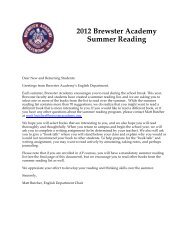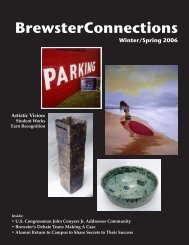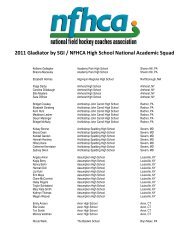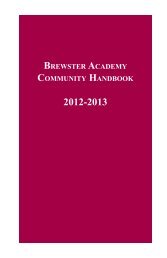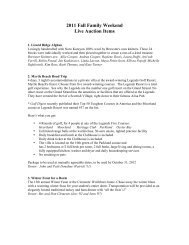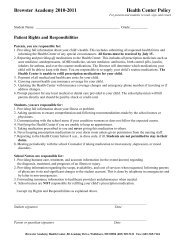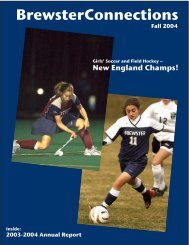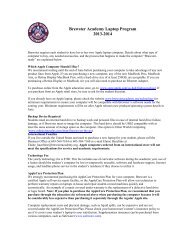BrewsterConnections - Brewster Academy
BrewsterConnections - Brewster Academy
BrewsterConnections - Brewster Academy
Create successful ePaper yourself
Turn your PDF publications into a flip-book with our unique Google optimized e-Paper software.
We Know What They Did Last Summer<br />
<strong>Brewster</strong> students are adventurous and giving of their time. Here Connections<br />
shares the stories of how some students spent their summer days and, for at<br />
least one stargazer, his nights.<br />
Rebecca<br />
Marisseau<br />
‘12 (Wolfeboro)<br />
spent two weeks<br />
at an Archaeology<br />
Field School at<br />
Strawbery Banke<br />
Museum in<br />
Portsmouth, New<br />
Hampshire.<br />
Why archaeology The Field School was excavating near the 1762 Chase<br />
House, which belonged to Stephen Chase, a wealthy Portsmouth merchant.<br />
Recently, Strawbery Banke staff began looking at old 18th century insurance<br />
maps and noticed that there were other structures on the property in 1762 that<br />
are not currently standing. Further research and archaeological investigation<br />
revealed that the structures were the original privy and carriage house.<br />
What Rebecca learned: Archeologists are very interested in excavating<br />
privies because when they were no longer privies they were used as trash<br />
receptacles. The families would throw food scraps, ceramics, glass, and anything<br />
else they deemed trash into the privy. This leaves evidence of day-to-day 18th<br />
century life for the archaeologists.<br />
I participated in the excavation of the former carriage house and privy<br />
foundations. Though I was fortunate enough to not have to dig in the privy itself,<br />
I was given a unit with many artifacts in it!<br />
What Rebecca and her team excavated: Two 1780-1820 pearlware<br />
teacups, Victorian thimble, animal bones (shows what they ate), part of a carriage<br />
wheel, leather, keys, horseshoes, thermometer, and a toothbrush.<br />
cover, and light from<br />
nearby stars to obtain<br />
accurate photometrical<br />
measurements.<br />
Why this course<br />
I chose this endeavor<br />
because of my strong<br />
interest in astronomy,<br />
which was inspired<br />
when I competed in<br />
the New Hampshire<br />
Astronomy Bowl last<br />
March.<br />
What Raymond<br />
learned: I learned<br />
about stellar/galactic<br />
formation, sky geography, atmospheric interference, and planetary processes. At<br />
the CTAS, I am learning how to set up and operate the observatory telescope,<br />
use various filters to determine the quality of camera exposures, and that the 15<br />
different exoplanets change in position and luminosity as they interfere with the<br />
light of nearby stars.<br />
My experience at CTAS has taught me to pay close attention to every detail<br />
on the computer data, since any error can possibly result in inaccurate<br />
measurements that can change the overall outlook of the transit observation(s).<br />
I have three mentors who are highly educated in physics, chemistry, and<br />
engineering. They are very detailed in all that they do in sharing their knowledge<br />
of astronomy. At UC Berkeley, I learned from my experience that life in a large<br />
university requires a huge responsibility from an individual to succeed because<br />
there is no supervision inside and outside of class.<br />
Raymond Soriano ’12 (Laredo, Texas) enrolled in a six-week course in<br />
astronomy and oceanography at the University of California, Berkeley. When he<br />
wrote the following, Raymond was in the middle of a two-week research project<br />
on the 15 exoplanet transit observations at the Central Texas Astronomical<br />
Society (CTAS).<br />
In particular, I am recording the luminosity of the exoplanets with various<br />
calibration filters as a means of taking into account signal-to-noise ratio, cloud<br />
Amy Misira ’12 (Cockeysville,<br />
Maryland) interned for the nonprofit<br />
Children Across Borders headquartered<br />
in Tampa, Florida. This organization<br />
provides sustained support in the form of<br />
education, health, housing, and wellness<br />
to underprivileged children throughout<br />
the world.<br />
10 <strong><strong>Brewster</strong>Connections</strong> – Fall 2011




